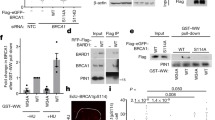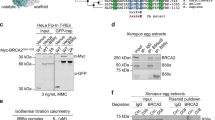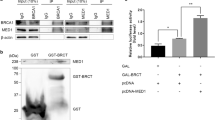Abstract
The BRCT regions are two repeating structures at BRCA1 carboxyl-terminus and are ubiquitous in some proteins involved in DNA repair and cell cycle checkpoints. It was shown that BRCTs of TopBP1, BRCA1, and BRCT-Ws of Rb bound DNA ends and breaks. We indicate here that the C-terminus of p53 tumor suppressor contains a DNA binding motif (residues 327–333 in human), whose features are similar to those of the part of BRCT-W in Rb with DNA binding activity. The short motif was required for the gel retardation activity of DNA fragments, since residues 311–333 showed the activity while residues 311–326 showed no activity. Significant numbers of total p53 and its fragments with the motif formed multimerizing complexes and associated with DNA ends and breaks. These results suggest the common presence of DNA binding motifs that can recognize DNA ends or damages in major tumor suppressors, Rb, BRCA1 and p53. The oncogenic activity of p53 C-terminus (residues 311–393) required both the DNA damage recognition motif and the repair enzyme-associating domain.
This is a preview of subscription content, access via your institution
Access options
Subscribe to this journal
Receive 50 print issues and online access
$259.00 per year
only $5.18 per issue
Buy this article
- Purchase on Springer Link
- Instant access to full article PDF
Prices may be subject to local taxes which are calculated during checkout






Similar content being viewed by others
References
Aurelio ON, Kong XT, Gupta S, Stanbridge EJ . 2000 Mol. Cell. Biol. 20: 770–778
Bennett M, Macdonald K, Chan SW, Luzio JP, Simari R, Weissberg P . 1998 Science 282: 290–293
Bork P, Hofmann K, Bucher P, Neuwald AF, Altschul SF, Koonin EV . 1997 FASEB J. 11: 68–76
Callebaut I, Mornon JP . 1997 FEBS Lett. 400: 25–30
Chai YL, Cui J, Shao N, Shyam E, Reddy P, Rao VN . 1999 Oncogene 18: 263–268
Chan TA, Hermeking H, Lengauer C, Kinzler KW, Vogelstein B . 1999 Nature 401: 616–620
Chen C, Okayama H . 1987 Mol. Cell. Biol. 7: 2745–2752
Clore GM, Omichinski JG, Sakaguchi K, Zambrano N, Sakamoto H, Appella E, Gronenborn AM . 1994 Science 265: 386–391
Cranston A, Bocker T, Reitmair A, Palazzo J, Wilson T, Mak T, Fishel R . 1997 Nat. Genet. 17: 114–118
Davison TS, Yin P, Nie E, Kay C, Arrowsmith CH . 1998 Oncogene 17: 651–656
Deng C, Zhang P, Harper JW, Elledge SJ, Leder P . 1995 Cell 82: 675–684
Innocente SA, Abrahamson JL, Cogswell JP, Lee JM . 1999 Proc. Natl. Acad. Sci. USA 96: 2147–2152
Ko LJ, Prives C . 1996 Genes Dev. 10: 1054–1072
Koonin EV, Altschul SF, Bork P . 1996 Nat. Genet. 13: 266–268
Lee S, Elenbaas B, Levine A, Griffith J . 1995 Cell 81: 1013–1020
Lomax ME, Barnes DM, Hupp TR, Picksley SM, Camplejohn RS . 1998 Oncogene 17: 643–649
Masuda H, Miller C, Koeffler HP, Battifora H, Cline MJ . 1987 Proc. Natl. Acad. Sci. USA 84: 7716–7719
Miki T, Smith CL, Long JE, Eva A, Fleming TP . 1993 Nature 362: 462–465
Miki Y, Swensen J, Shattuck-Eidens D, Futreal PA, Harshman K, Tavtigian S, Liu Q, Cochran C, Bennett LM, Ding W, Bell R, Rosenthal J, Hyssey C, Tran T, McClure M, Frye C, Hattier T, Phelps R, Haugen-Strano A, Katcher H, Yakumo K, Gholami Z, Shaffer D, Stone S, Bayer S, Wray C, Bogden R, Dayanath P, Ward J, Tonin P, Narod S, Bristow P, Norris F, Helvering L, Morrison P, Rosteck P, Lai M, Barrett JC, Lewis C, Neuhausen S, Cannon-Albright L, Goldgar D, Wiseman R, Kamb A, Skolnick M . 1994 Science 266: 66–71
Mimori T, Hardin JA . 1986 J. Biol. Chem. 261: 10375–10379
Oda K, Arakawa H, Tanaka T, Matsuda K, Tanikawa C, Mori T, Nishimori H, Tamai K, Tokino T, Nakamura Y, Taya Y . 2000 Cell 102: 849–862
Pavletich NP, Chambers KA, Pabo CO . 1993 Genes Dev. 7: 2556–2564
Reed M, Woelker B, Wang P, Wang Y, Anderson ME, Tegtmeyer P . 1995 Proc. Natl. Acad. Sci. USA 92: 9455–9459
Selivanova G, Iotsova V, Kiseleva E, Strom M, Bakalkin G, Grafstrom RC, Wiman KG . 1996 Nucleic Acids Res. 24: 3560–3567
Shaulsky G, Goldfinger N, Ben-Ze'ev A, Rotter V . 1990 Mol. Cell. Biol. 10: 6565–6577
Stommel JM, Marchenko ND, Jimenez GS, Moll UM, Hope TJ, Wahl GM . 1999 EMBO J. 18: 1660–1672
Thukral SK, Blain GC, Chang KK, Fields S . 1994 Mol. Cell. Biol. 14: 8315–8321
Tyler JM, Branton D . 1980 J. Ultrastruct. Res. 71: 95–102
Vieira J, Messing J . 1982 Gene 19: 259–268
Wang P, Reed M, Wang Y, Mayr G, Stenger JE, Anderson ME, Schwedes JF, Tegtmeyer P . 1994 Mol. Cell. Biol. 14: 5182–5191
Wang XW, Yeh H, Schaeffer L, Roy R, Moncollin V, Egly JM, Wang Z, Freidberg EC, Evans MK, Taffe BG, Bohr VA, Weeda G, Hoeijmakers JHJ, Forrester K, Harris CC . 1995 Nat. Genet. 10: 188–195
Wang Y, Reed M, Wang P, Stenger JE, Mayr G, Anderson ME, Schwedes JF, Tegtmeyer P . 1993 Genes Dev. 7: 2575–2586
Wu L, Bayle JH, Elenbaas B, Pavletich NP, Levine AJ . 1995 Mol. Cell. Biol. 15: 497–504
Yamane K, Katayama E, Sugasawa K, Tsuruo T . 2000a Oncogene 19: 1982–1991
Yamane K, Katayama E, Tsuruo T . 2000b Biochem. Biophys. Res. Commun. 279: 678–684
Yamane K, Kawabata M, Tsuruo T . 1997 Eur. J. Biochem. 250: 794–799
Yamane K, Tsuruo T . 1999 Oncogene 18: 5194–5203
Zakut-Houri R, Bienz-Tadmor B, Givol D, Oren M . 1985 EMBO J. 4: 1251–1255
Acknowledgements
This study was supported by the Program for Promotion of Fundamental Studies in Health Sciences of the Organization for Pharmaceutical Safety and Research of Japan.
Author information
Authors and Affiliations
Rights and permissions
About this article
Cite this article
Yamane, K., Katayama, E. & Tsuruo, T. p53 contains a DNA break-binding motif similar to the functional part of BRCT-related region of Rb. Oncogene 20, 2859–2867 (2001). https://doi.org/10.1038/sj.onc.1204408
Received:
Revised:
Accepted:
Issue Date:
DOI: https://doi.org/10.1038/sj.onc.1204408



